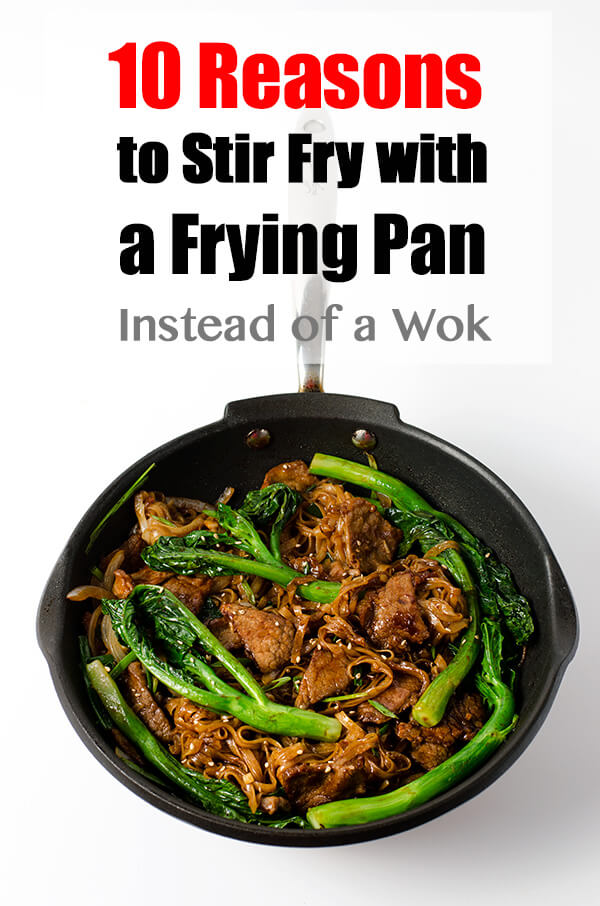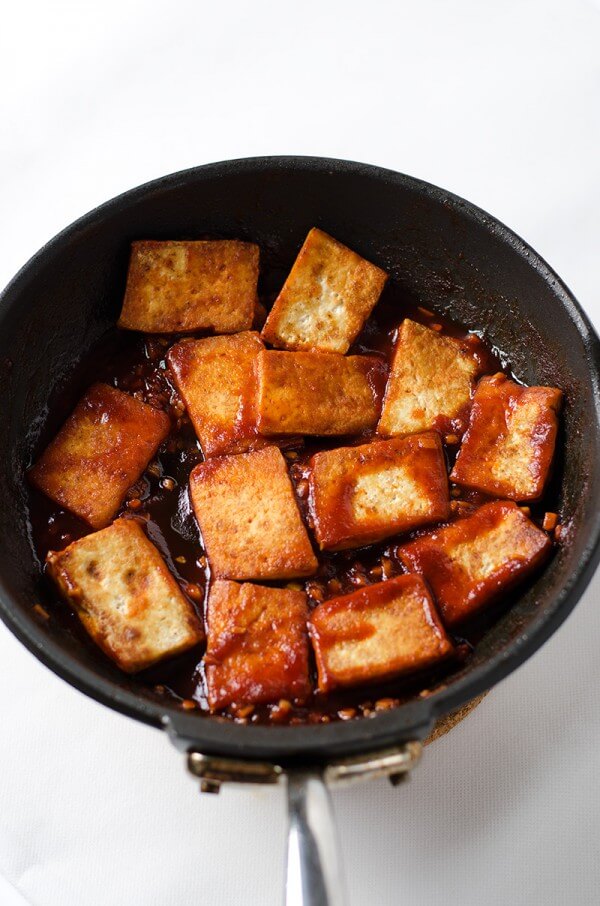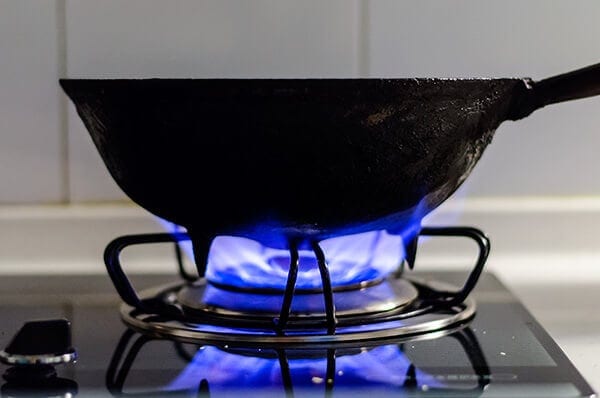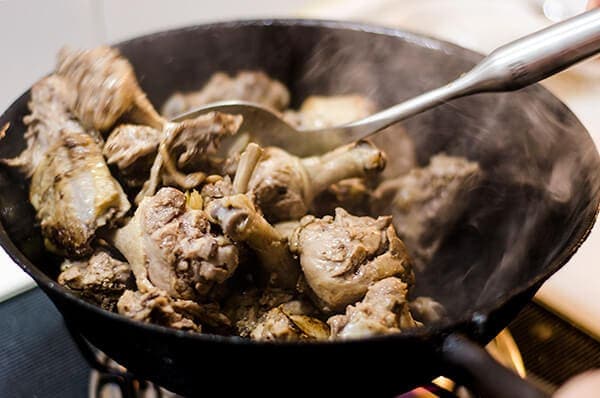
Do you like stir fried food and want to cook it at home with minimal equipment? Are you afraid of trying out stir fry recipes because you don’t own a wok? Do you hate cooking with a wok, because the smoke sets off your fire alarm all the time? If you answered yes to any of these questions, this article will be very helpful to you.
No matter whether searching on the internet or browsing through cookbooks, the word “wok” will jump out every time. Everyone seems to claim it’s necessary to own a wok and that using a wok is the only way to cook good stir fried food. Well, I really doubt that.
Don’t get me wrong. I grew up in China and my family uses a wok to cook every day. I know how to use a wok and I do like to make stir fry with it. However, I prefer to use my heavy bottom nonstick frying pan to cook most of the stir fried dishes on a daily basis. Below are the 10 reasons you should use a frying pan to make stir fried dishes instead of a wok.
1. You don’t need to buy a wok and extra equipment
A wok might not be expensive. But why buy it and take up space to keep it in any case, if you can create stir fried food with the kitchen wares you already have? You should also consider the extra equipment you have to purchase with the wok, which includes a metal turner, a wok lid, and a wok ring (if you use the traditional round bottom wok).
2. You don’t need to take extra care to store the wok
A standard cast iron wok will get rusty if you don’t use it over time. You have to rub it with oil regularly to keep it in good shape. Chances are, when you finally decide to cook a stir fried dish and go to the garage to fetch the wok, it is already unusable.

3. A frying pan can generate great stir fried dishes, too
I won’t say you could replicate 100% of dishes using a frying pan to get the exactly the same result, as you’d get using a wok. But you can make delicious and authentic stir fried dishes with a frying pan. If you look at the black pepper steak or fish fragrant eggplant, you will find that a frying pan can create authentic Chinese stir-fry easily.
4. A nonstick frying pan uses less than half the oil a wok does
You will only need half or even one third the oil if you’re cooking stir-fry with a nonstick frying pan. Believe me, even if you heat the wok very well and follow all the instructions from the cookbook, certain items will still stick to the wok and get burnt. Moreover, not all stir fry requires a super high oil temperature. You could easily handle with them with a non-sticky frying pan and use much less oil. Try to cook vegetable and ham fried rice with a wok, and you will be surprised how much oil you’ll need to use to keep the rice from sticking to the wok.
If you’re worried about safety issues surrounding teflon material, I have some good news for you. New nonstick frying pans have progressed a lot. They can stand very high heat (most of them can be heated up to 500 degrees F, while most stir fried dishes require 400 F heat or less). They can coat with oil better and last a very long time.

5. A frying pan can do what a wok cannot
Believe it or not, a frying pan actually can do more than a wok. If you look at sweet and sour tofu or mapo tofu, you will find that a flat bottom pan can easily deal with tofu without breaking the pieces apart.
6. Easier for beginners
You need to heat up a wok to very high heat no matter what dish you’re cooking, and cook it within a very short span of time to achieve good results. If you look at the real chefs who work in Chinese restaurants, you will be surprised that it only takes a few seconds to sear the meat or mix in the sauce (You will also be surprised at the huge amount of oil they use). A frying pan will take more time (for example 30 seconds VS. 10 seconds) to completely cook meat/veggies and is thus easier for beginners to learn and get used to.
7. Safer for beginners
If you’re not familiar with cooking with a wok, the temperature of the oil will quickly get too high to handle. Again, you have to be heat up the wok very well before cooking, even for some food that doesn’t require high heat. The heated wok will get out of control if you don’t adjust heat constantly, and most of it requires experience and is not listed in the recipe.

8. A wok doesn’t work well on an electric stove top
A traditional round bottomed wok is not designed to cook on an electric stove top and you need to get a wok ring. However, a wok ring does not hold the wok as steadily as a flat one. Moreover, the wok will be too far away from the heat source, so the upper metal of the wok won’t heat up well enough. A flat wok is an alternative, but it requires more cooking oil and the upper third still won’t heat up so well. On the other hand, you don’t need a high power gas stove to cook with frying pan and it will heat up very well.
9. Easier to clean up
Even a heavy frying pan is still lighter than a wok and can be easily cleaned up in a dishwasher. If you use a nonstick frying pan, you should not put it in a dishwasher, but it is much easier to clean because of its material.
To clean a wok, you have to do it immediately after cooking, while it’s still hot. You cannot use detergent with a wok, and you cannot soak it in water (the cast iron will get rusty). If you accidentally burn the food or don’t clean up the wok on time, you’ll be in a lot of trouble.

10. A frying pan won’t set off your fire alarm so often and make your house unlivable
If you use a wok to cook stir fried dishes properly, it will get so smoky and will set off your fire alarm constantly. Unfortunately, there is not much you can do, because wok hei (“wok air” by direct translation) is the only reason a wok works and makes the food taste so good. Wok cooking is so smoky and smelly, which is why Chinese families don’t have open kitchens (we turn on the exhaust fan, open the kitchen window, close the kitchen door, and the living room still smells like a restaurant). Cooking with a wok every day in your big open kitchen will cause you to have to repaint the walls every 3 months and the connected rooms unlivable. No kidding.
I admit, to stir fry with a frying pan generates smoke as well (in order to make better food). But the smoke is not as abundant as with a wok and you can use an exhaust fan to solve most the problem.
Final thought
A wok might be nice to have, as long as you like cooking Chinese food and want to prepare it authentically. It requires some practice and getting used to, but you will be amazed by the great smoky flavor of the stir fried dish that cooked with a wok. On the other hand, if you only cook Chinese food occasionally, only have electric stove at home, or want to use less oil in your cooking, I recommend you to invest in a high quality frying pan. Besides stir fry, a heavy bottomed frying pan could help make almost all your dishes taste better.
Now it’s your turn…
Do you prefer to use a wok or a frying pan? Leave a comment below to share your experience with us!

Mike
If you have GAS, a light hand beaten well seasoned wok is a joy to use – for low fat we use stocks or 1tsp oil
Liz
I just came to this post from your article about cooking dry-fried Szechuan-style green beans. It was so reassuring to read! In the decade since I left home myself and various Chinese roommates have had a lot of frying pans, a lot of woks and a lot of rental cookers and eventually all came to the conclusion that a wok was a waste of space unless you had a gas burner, ideally a high-powered burner like a restaurant. I have a very small galley kitchen but I use my thick-bottomed stainless steel saute pan all the time and things like grilling steaks or blistering those green beans turn out great in it, which I don’t believe they would in a non-stick pan that couldn’t get as hot or be scrubbed if things stuck to it – I find with non-stick that eventually when something DOES stick, the pan is effectively ruined, whereas stainless or cast iron can be rescued. I’ve had the same stainless steel pans for many years still in great condition whereas I got sick of non-stick pans because I found despite using non-scratch utensils they would usually be scratched up and damaged within a year or so of use and I would have to throw them out and buy a new one. I now keep a smaller non-stick frying pan around just for frying eggs and making pancakes and do all my day-to-day intensive cooking in stainless steel.
Growing up, my mum used cast iron but I just find them too heavy and impractical!
Michele
Do you think using liquid smoke in a regular heavy bottomed frying pancould help replicate the smoky wok flavor?
Maggie Zhu
You definitely can add liquid smoke, although the smoky flavor will taste different. So I’d say it’s not 100% replicate.
Bert
Can I use my regular de Buyer Carbon Steel Frying pan to do stir fries? I am using electric stove
Maggie Zhu
Yes! That’s my favorite pan to use and it works great on an electric stove.
Anne Coles
Your article on using a frying pan was so helpful. I’ve just prepared a stirfry for 4 and wanted to try a frying pan but doubtful. I have a small wok which I used previously on my gas cooker but because I hadn’t got the stand for it, I knocked it over got slightly burnt, had to clean the kitchen floor and start again and didn’t want a repetition.
Morgan W
I use a round bottom wok, but only because (in my parents house) there is a special high BTU gas burner on their stovetop. You definitely need everything prepped and to have the steps memorized because it cooks so quickly. When I lived in FL and had a regular gas stove and used a wok it would take too long to cook or wouldn’t get hot enough. If I ever build my own house, a high BTU burner will be on my ‘want’ list for my kitchen!
Judith Mack
I’ve just been watching the very funny videos made by a British comedian of Malaysian descent, Nigel Ng where, in his stage persona “Uncle Roger”, he roasts chefs for not making fried rice to his liking – which is in the Malaysian way. He is outraged that Jamie Oliver uses a frying pan, not a wok. Glad to find your article discussing the pros and cons. I’m not quite clear as to whether the temperature of the oil in a frying pan is meant to be lower than in a wok; it would have to be, wouldn’t it, or the food would burn from so much contact with the base of the pan.
Peter Foy
I have an induction hob top and a flat bottomed non-stick coated wok (by Stellar) and get acceptable results.
Ray
I don’t agree at all with this. First off, there are plenty of non-stick woks out there, so using less oil as a result also applies to woks. The base is also much smaller than a 12 inch skillet, allowing you to use even less oil than the skillet. The high walls allow you to push the food that’s on the bottom, to the top, making it much easier to “stir” the food as it fries, giving you more consistent frying results.
Anthony Shydohub
A wok is great for a Chinese restaurant, not for your home. Not practical, smoky, too much oil, etc.
A large saute pan on an electric cooktop works for me and it can get very hot, if needed.
Bob
I use a Lodge cast iron wok on a gas stove, and if you let it heat up for 5 minutes, wow, it’s amazing. I used to have an electric stove, and no matter what kind of wok I used – and I tried them all – they were all disappointing. Flat bottom, round bottom with a ring, steel, non-stick…so frustrating. The Lodge changed everything. Round on the inside, flat on the outside, with a huge thermal mass. It changed my life. And now on gas, it’s the real deal. But you need very good ventilation!
Maggie Zhu
I’ve tried the Lodge cast iron wok in the past and I love its performance on a gas range. However, I have trouble with it when I used it on an electric stove. The bottom tends to heat up a bit too hot before the side of the wok heats up, so sometimes I ended up with burned spices while the food is not properly cooked. I think it’s because the flat surface is still quite small. Or maybe my electric stove was extra weak…
Marianne Gizzi
I was really thinking about getting a wok. Your article helped me decide. No wok.
joel lippman
Hi,
Liked your article thought it was very informative. I am retired chef who has just gotten interested in cooking authentic Asian foods so I can get all the garlic, onions and ginger I want in my diet for arthritis relief. I am really enjoying all the crunchy veggies and love the noodles which I am not a big pasta fan. I have an Ikea, oumbarlig non stick wok and I love it. I can toss my fried rice and veggie stir fries and I’m not constantly picking up flying stuff. I installed a HD burner ring on my electric stove and after a little practice I am learning to get better every time I use it. At first I used a frying pan and it would be fine if I didn’t have a wok but I love the wok. I did buy a 13″ skillet like pan to make egg foo young patties and for pad thai , especially when it comes to putting in the eggs. I did try a carbon steel wok, everything stuck and it was cured too. and a different non stick wok that didn’t have high sides like the Ikea and returned them both. for me the thing I didn’t like about the non stick Ikea at first is I have never been a fan of silicone cooking tools but found some that are very rigid and gotten used to them. Really enjoying all the veggie dishes especially the eggplant in garlic sauce and hope all of you have the same great experience I ma having learning a new wonderful cuisine.
Kenni
This was the exact comparison and feedback I was looking! I was considering a wok to make a vermicelli noodle dinner. But I think I’ll just use my frying pan.